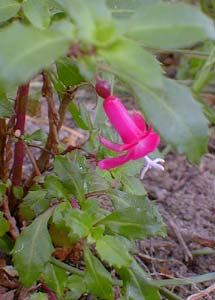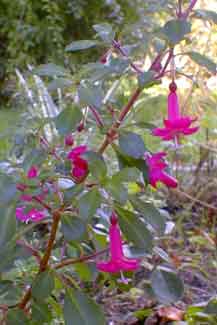
Dwarf Fuchsia
"For tiny hopes like tiny flowers of Spring
Will come, though death & ruin hold the land,
Though storms may roar they may not break the wing
Of the earthed lark whose song is ever bland."
-Lt. Alfred Victor Ratcliffe
(1897-1916)
(1897-1916)
Dwarf Emcliandra or Dwarf Fuchsia (Fuchsia x bacillaris) is hybrid of F. thymifolia with F. microphylla which probably originated naturally in the wilds Central American. It has been so long gardened no one is quite certain if it was or was not first found in the wild, but current thinking leans toward it being a spontaneous hybrid.
Originating in high mountainous cloud forests, it tolerates chilliness much better than it tolerates heat. It is nearly evergreen here in Zone 8, though a mild degree of frost damage can be expected, & a week of temperatures into the twenties Fahrenheit will cause very late-winter or pre-spring die-back. It will otherwise produce even the occasional flower in winter, though it is most floriferous in late spring through early autumn.
 It tends to flower on young branches & upper branches, so a pre-spring or early spring pruning is good for it, not only to repair any winter injury but to encourage new growth that will be floweriest.
It tends to flower on young branches & upper branches, so a pre-spring or early spring pruning is good for it, not only to repair any winter injury but to encourage new growth that will be floweriest.The white-stamined deep coral flowers are very small, & the shrub itself compact with tiny serrated leaves. It is perfect for tiny garden spaces & adaptable for bonsai, & is as hardy for container gardening as it is in the open garden.
The June (2003) photo at top shows the bloom more than twice life size, so it's much more a woodland charmer than it is like the usual sorts of fuchsias with flowery impact. The second photo is from September's end (2004).
Hummingbirds like to lift the tubes to poke inside. As with other fuchsias, it is a good idea to give a monthy liquid fertilizing during the primary bloom seasons.
I have never spotted this locally in other peoples' gardens, lending me to suppose it is just not widely utilized, perhaps because the flowers are so much smaller than peoples' expecations from fuchsias. I find the wee blooms to be the cutest things, & for their size they're surprisingly showy against such dark green leaves.
Overall, as a compact shrub, it is much smaller than the hardy fuchsias of the F. magellanica varieties, rarely exceeding three feet round, & even that would be a pretty old clump. Ours is planted on a stone ledge by a patio where it can be fully appreciated as a miniature.
It requires dappled shade in a moist location with rich humusy soil. It is semi-resistant to mites & highly resistant to fuchsia gall.